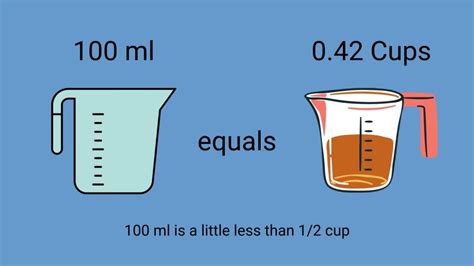How Many Ml In 3.4 Ounces
Kalali
Mar 26, 2025 · 4 min read

Table of Contents
How Many ml in 3.4 Ounces? A Comprehensive Guide to Fluid Conversions
Knowing how to convert between different units of measurement is a crucial skill, especially when dealing with recipes, scientific experiments, or everyday tasks involving liquids. One common conversion involves ounces and milliliters. This comprehensive guide will delve into the question: How many ml in 3.4 ounces? We'll explore the conversion process, address common misconceptions, and provide you with the tools to confidently handle various fluid conversions.
Understanding Ounces and Milliliters
Before jumping into the conversion, let's clarify what ounces and milliliters represent.
-
Ounces (oz): This is a unit of volume commonly used in the United States and some other countries. There are two types: fluid ounces (fl oz) which measure volume, and avoirdupois ounces, which measure weight. When dealing with liquids, we're always referring to fluid ounces.
-
Milliliters (ml): This is a unit of volume based on the metric system, widely used internationally. A milliliter is one-thousandth of a liter. The metric system's standardized structure makes conversions relatively straightforward.
The Conversion Factor: The Key to Accuracy
The fundamental element in any unit conversion is the conversion factor. This factor establishes the relationship between the two units. For ounces and milliliters, the generally accepted conversion factor is:
1 fluid ounce (fl oz) ≈ 29.5735 milliliters (ml)
The "≈" symbol indicates an approximation. While the conversion isn't exact, 29.5735 ml is a close enough approximation for most purposes. Using more decimal places provides greater accuracy, but for everyday conversions, this level of precision is often sufficient.
Calculating ml in 3.4 Ounces
Now, let's tackle the core question: how many ml are there in 3.4 ounces? The calculation is simple multiplication:
3.4 fl oz * 29.5735 ml/fl oz ≈ 100.6 ml
Therefore, approximately 100.6 milliliters are equivalent to 3.4 fluid ounces.
Common Conversion Errors and How to Avoid Them
Several common pitfalls can lead to inaccurate conversions. Let's address them:
-
Using the wrong type of ounce: Remember, we're dealing with fluid ounces, not avoirdupois ounces (weight). Using the wrong type will result in a completely incorrect answer.
-
Rounding errors: While rounding is convenient, excessive rounding early in the calculation can accumulate errors, especially when dealing with multiple conversions. It's best practice to round only at the very end.
-
Inconsistent units: Ensure all your measurements use the same unit system (either metric or imperial) before starting the conversion to prevent confusion and mistakes.
Beyond 3.4 Ounces: Mastering Fluid Conversions
Understanding the conversion between ounces and milliliters allows you to tackle a wide range of similar conversions. Here's how to apply the principles we've discussed to other scenarios:
Converting Ounces to Milliliters: A Step-by-Step Guide
-
Identify the number of fluid ounces: Determine the exact quantity you need to convert.
-
Apply the conversion factor: Multiply the number of fluid ounces by 29.5735 ml/fl oz.
-
Calculate and round: Perform the multiplication and round the result to the desired level of precision.
Converting Milliliters to Ounces: The Reverse Calculation
The reverse conversion (milliliters to ounces) involves dividing by the conversion factor:
-
Identify the number of milliliters: Start with the quantity in milliliters.
-
Apply the conversion factor: Divide the number of milliliters by 29.5735 ml/fl oz.
-
Calculate and round: Perform the division and round the result to the desired level of precision.
Practical Applications: When You Need to Know
Understanding fluid conversions is essential in various situations:
-
Cooking and Baking: Many international recipes use milliliters, while American recipes often use fluid ounces. Accurate conversions ensure your dishes turn out perfectly.
-
Medicine: Accurate dosing is crucial, and converting between different volume units is essential for safe and effective medication administration.
-
Science Experiments: Precise measurements are vital in scientific research and experiments. Accurate conversions are necessary for reproducible results.
-
DIY Projects: Whether it's mixing paints, creating cleaning solutions, or working with other liquids, accurate conversions are essential for success.
Tools and Resources for Fluid Conversions
While manual calculation is a valuable skill, numerous online tools and calculators can expedite the conversion process. These tools often provide greater accuracy and handle more complex conversions involving other units. Search for "ounce to milliliter converter" to find various online options.
Conclusion: Precision in Measurement
The question of how many ml are in 3.4 ounces highlights the importance of accurate fluid conversions. By understanding the conversion factor and the potential pitfalls, you can confidently handle these conversions in various settings. Whether you are cooking, conducting experiments, or working on a DIY project, accurate measurements contribute to successful outcomes. Mastering this essential skill empowers you to navigate a world of measurements with confidence and precision. Remember the key: 1 fl oz ≈ 29.5735 ml. Use this knowledge, and your conversions will always be spot on!
Latest Posts
Latest Posts
-
What Is 38 Degrees Centigrade In Fahrenheit
Mar 29, 2025
-
5000 Milliliters Is How Many Liters
Mar 29, 2025
-
What Is 1 3 Cup In Oz
Mar 29, 2025
-
How Many Valence Electrons In Transition Metals
Mar 29, 2025
-
What Is The Gcf Of 12 And 18
Mar 29, 2025
Related Post
Thank you for visiting our website which covers about How Many Ml In 3.4 Ounces . We hope the information provided has been useful to you. Feel free to contact us if you have any questions or need further assistance. See you next time and don't miss to bookmark.
